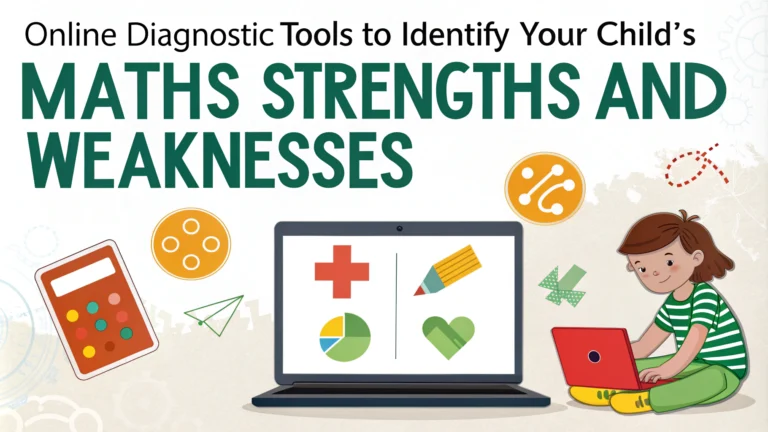Identifying a child’s math strengths and weaknesses is key to tailored learning. Online diagnostic tools offer a convenient way to assess math skills, providing insights for targeted improvement. This article explores effective digital resources to evaluate your child’s mathematical abilities.
Understanding the Importance of Math Diagnostics
Math diagnostic tools pinpoint areas where students excel or struggle. They help create personalized learning plans, boosting confidence and academic performance. These assessments provide valuable data for parents and teachers to support a child’s math journey.
Benefits of Online Math Diagnostics:
- Immediate feedback
- Customized learning paths
- Progress tracking over time
- Identification of specific skill gaps
Top Online Math Diagnostic Tools
Several reputable platforms offer comprehensive math assessments for children and teens. Here’s a selection of effective tools:
| Tool Name | Age Group | Key Features |
|---|---|---|
| Khan Academy | 5-18 | Free, adaptive learning, wide range of topics |
| IXL Math | Pre-K to 12 | Comprehensive diagnostics, detailed reports |
| ALEKS | 3rd grade to college | AI-powered assessments, personalized learning |
How to Choose the Right Diagnostic Tool
Selecting an appropriate math diagnostic tool depends on various factors. Consider these points when making your choice:
- Age appropriateness: Ensure the tool matches your child’s grade level
- Curriculum alignment: Check if it aligns with your local or national standards
- User-friendliness: Look for intuitive interfaces for both children and parents
- Reporting features: Opt for tools that provide clear, actionable insights
- Adaptive technology: Choose platforms that adjust to your child’s skill level
Remember, the best tool is one that your child will engage with consistently. Consider their learning style and preferences when making your selection.
Implementing Math Diagnostics in Your Child’s Routine
Integrating math diagnostics into your child’s learning schedule can significantly boost their progress. Here’s how to make it work:
- Set a regular schedule: Dedicate specific times for assessments
- Create a distraction-free environment: Ensure a quiet space for focused work
- Offer incentives: Reward consistent participation and improvement
- Review results together: Discuss strengths and areas for growth
Regular use of diagnostic tools helps track progress and keeps your child motivated. It also allows for timely adjustments to their learning plan.
Interpreting Diagnostic Results
Understanding the results is key to making the most of math diagnostics. Here’s what to look for:
- Skill gaps: Identify specific areas where your child struggles
- Mastery levels: Note topics where your child excels
- Progress over time: Compare results from different assessments
- Recommended next steps: Follow suggested learning paths
Use these insights to guide discussions with teachers and tutors. They can help create targeted strategies for improvement.
Sample Result Interpretation
| Topic | Mastery Level | Recommended Action |
|---|---|---|
| Addition | 90% | Move to advanced concepts |
| Fractions | 60% | Review basics and practice regularly |
| Geometry | 75% | Reinforce with real-world examples |
Complementing Diagnostics with Hands-On Activities
While online tools are valuable, hands-on activities can reinforce learning and make math more engaging. Try these ideas:
- Math games: Use board games or card games that involve calculations
- Cooking projects: Practice fractions and measurements in the kitchen
- Building challenges: Use blocks or LEGO to explore geometry concepts
- Shopping activities: Calculate discounts and budgets during shopping trips
These activities provide real-world context for math concepts and help solidify skills identified in diagnostics.
Addressing Math Anxiety Through Diagnostics
Math diagnostics can help reduce math anxiety by:
- Breaking down large concepts: Focusing on specific skills makes math less overwhelming
- Celebrating small wins: Recognizing progress boosts confidence
- Providing a safe learning environment: Low-stakes assessments reduce pressure
- Personalizing the learning journey: Tailored approaches make math more accessible
Encourage a positive attitude towards math by framing diagnostics as tools for growth, not judgment.
Conclusion: Empowering Mathematical Growth
Online math diagnostic tools offer a powerful way to support your child’s mathematical development. By regularly assessing skills, interpreting results, and complementing online tools with hands-on activities, you can create a comprehensive approach to math education.
Remember these key points:
- Consistency is key: Regular use of diagnostics yields the best results
- Combine methods: Balance online tools with real-world math applications
- Stay positive: Use diagnostics to celebrate progress and identify growth opportunities
- Communicate: Share insights with teachers to create a unified support system
With the right approach, math diagnostics can transform your child’s learning experience, fostering confidence and competence in mathematics.

